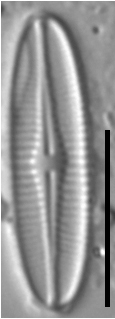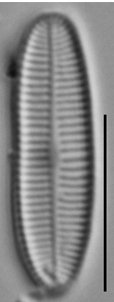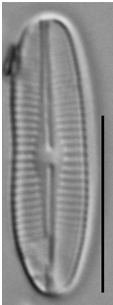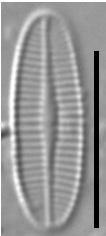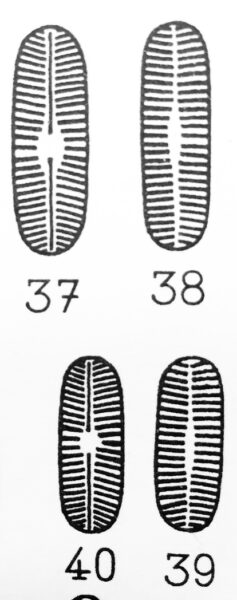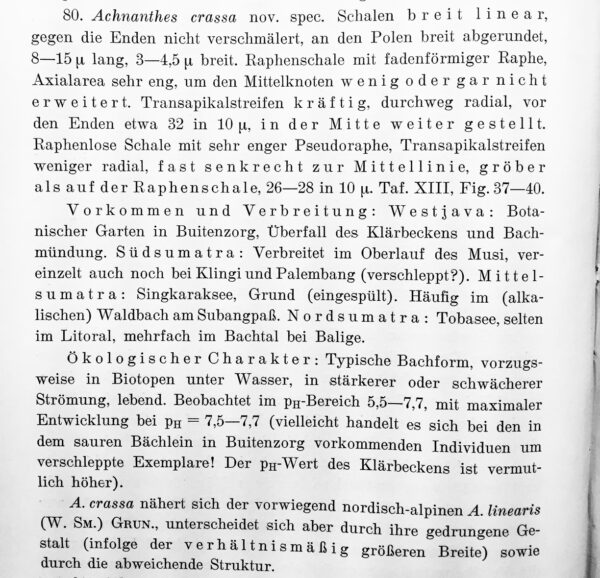Achnanthidium crassum
-
Category
-
Length Range7.3-19.6 µm
-
Width Range3.1-4.5 µm
-
Striae in 10 µm17-24
-
SynonymsAchnanthes crassa Hust.
-
ContributorMeredith Tyree Polaskey - Feb 2018
-
ReviewerMarina Potapova, Sarah Spaulding - May 2018
Identification
Description
Valves are elliptic to elliptic-lanceolate with broadly rounded ends. The raphe valve is concave. The raphe valve possesses a narrow linear-lanceolate axial area, which expands slightly at center valve. The proximal raphe ends are “tear-drop”-shaped externally, and the distal raphe ends are unilaterally deflected. The rapheless valve is convex. The axial area on the rapheless valve is narrow, linear and barely expanded at center valve. Striae on both the raphe and rapheless valves are parallel to barely radiate at mid-valve, becoming radiate at the ends. Stria density of the raphe valve is 20-24 in 10 μm at mid-valve, becoming 36-40 in 10 μm at the ends. Stria density of the rapheless is 20-24 in 10 μm at mid-valve, becoming 35-40 in 10 μm at the ends.
Achnanthidium crassum bears a strong resemblance to A. rivulare, but has been regarded as a separate species based on a slightly larger length-to-width ratio and radiate striae at the apices on the raphe valve. Achnanthidium crassum was originally considered to have a distribution limited to tropical regions (Potapova and Ponader 2004). However, A. crassum has since been confirmed throughout the northeast, northwest and southeast United States, and can occur concurrently in samples with A. rivulare. Raphe valves of each species can be distinguished from one another using a light microscope with differential interference contrast (DIC) able to resolve the striae orientation at the apices. However, rapheless valves of A. crassum differ from A. rivulare only by having a slightly larger length-to-width ratio that differs by less than 1 μm, making distinction of these two species dependent upon critical examination. Further studies are required to clarify the ecology and taxonomy of these two species.
Autecology
Few records exist of A. crassum, but this species has likely historically been misidentified as A. rivulare due to morphological similarity of the two species and a mistaken perception that A. crassum occurs only in tropical regions.
Achanthidium crassum was originally described from Sumatra (Hustedt 1937) and has been reported from Hawaii (Potapova and Ponader 2004). Juttner et al. (2001) reported A. crassum from the Himalayas in relatively wide, deep streams and found the species to be positively correlated with agricultural land use. We confirmed A. crassum throughout the northeast, northwest, and southeast United States in both lentic and lotic environments, often in moderately high abundance in sites ranging from reference-quality to highly urban.
-
Size Range, µm3
-
Motility
-
Habitat
-
Colony
-
Waterbody
-
Distribution
- Learn more about this
Original Description
80. Achnanthes crassa nov. spec. Schalen breit linear, gegen die Enden nicht verschmälert, an den Polen breit abgerundet, 8-15 μ lang, 3-4,5 μ breit. Raphenschale mit fadenförmiger Raphe, Axialarea sehr eng, um den Mittelknoten wenigodergarnicht erweitert. Transapikalstreifen kräftig, durchweg radial, vor den Enden etwa 32 in 10 μ, in der Mitte weiter gestellt. Raphenlose Schale mit sehr enger Pseudoraphe, Transapikalstreifen weniger radial, fast senkrecht zur Mittellinie, gröber alsaufder Raphenschale, 26-28 in 10 μ. Taf. XIII, Fig. 37-40.
Vorkommen und Verbreitung Westjava: Bota-nischer Garten in Buitenzorg, Überfall des Klärbeckens und Bach-mündung. Südsumatra: Verbreitet im Oberlauf des Musi, ver-einzelt auch noch bei Klingi und Palembang (verschleppt?). Mittel-sumatra: Singkaraksee, Grund (eingespült). Häufig im (alka-lischen) Waldbach am Subangpaẞ. Nordsumatra: Tobasee, selten im Litoral, mehrfach im Bachtal bei Balige.
Ökologischer Charakter: Typisch Bachform, vorzugs-weise in Biotopen unter Wasser, in stäkerer oder schwächerer Strömung, lebend. Beobachtet im pH-Bereich 5,5-7,7, mit maximaler Entwichlung bei pH=7,5-7,7 (vielleicht handelt es sich bei den in dem sauren Bächlein in Buitenzorg vorkommenden Individuen um verschleppte Exemplare! Der pH-Wert des Klärbeckens ist vermut-lich höher).
A. crassa nähert sich der vorwiegend nordisch-alpinen A. linearis (W. Sm.) Grun., unterscheidet sich aber durch ihre gedrungene Ge-stalt (infolge der verhältnismäẞig gröẞeren Breite) sowie durch die abweichende Struktur.
-
BasionymAchnanthes crassa
-
AuthorHust. 1937
-
Length Range8-15 µm
-
Width3-4.5 µm
-
Striae in 10µmraphe valve 32 at the ends, rapheless valve 26-28
Citations & Links
Citations
-
Publication Link: 10.1127/1864-1318/2011/0136-0045
Cite This Page
Polaskey, M. (2018). Achnanthidium crassum. In Diatoms of North America. Retrieved November 21, 2024, from https://diatoms.org/species/achnanthidium_crassum
Responses
The 15 response plots show an environmental variable (x axis) against the relative abundance (y axis) of Achnanthidium crassum from all the stream reaches where it was present. Note that the relative abundance scale is the same on each plot. Explanation of each environmental variable and units are as follows:
ELEVATION = stream reach elevation (meters)
STRAHLER = distribution plot of the Strahler Stream Order
SLOPE = stream reach gradient (degrees)
W1_HALL = an index that is a measure of streamside (riparian) human activity that ranges from 0 - 10, with a value of 0 indicating of minimal disturbance to a value of 10 indicating severe disturbance.
PHSTVL = pH measured in a sealed syringe sample (pH units)
log_COND = log concentration of specific conductivity (µS/cm)
log_PTL = log concentration of total phosphorus (µg/L)
log_NO3 = log concentration of nitrate (µeq/L)
log_DOC = log concentration of dissolved organic carbon (mg/L)
log_SIO2 = log concentration of silicon (mg/L)
log_NA = log concentration of sodium (µeq/L)
log_HCO3 = log concentration of the bicarbonate ion (µeq/L)
EMBED = percent of the stream substrate that is embedded by sand and fine sediment
log_TURBIDITY = log of turbidity, a measure of cloudiness of water, in nephelometric turbidity units (NTU).
DISTOT = an index of total human disturbance in the watershed that ranges from 1 - 100, with a value of 0 indicating of minimal disturbance to a value of 100 indicating severe disturbance.
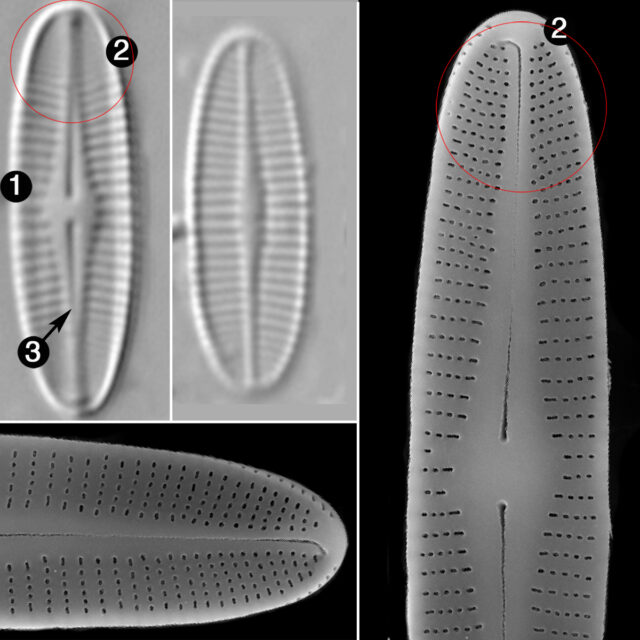
Achnanthidium crassum
- Striae parallel at center valve
- Striae radiate at apices
- Axial area narrow
Both raphe and rapheless valves have striae that are parallel at the center valve, becoming radiate at the apices. The axial area is narrow, but widened at the valve center. Areolae are unresolvable in LM.
 Diatoms of North America
Diatoms of North America
